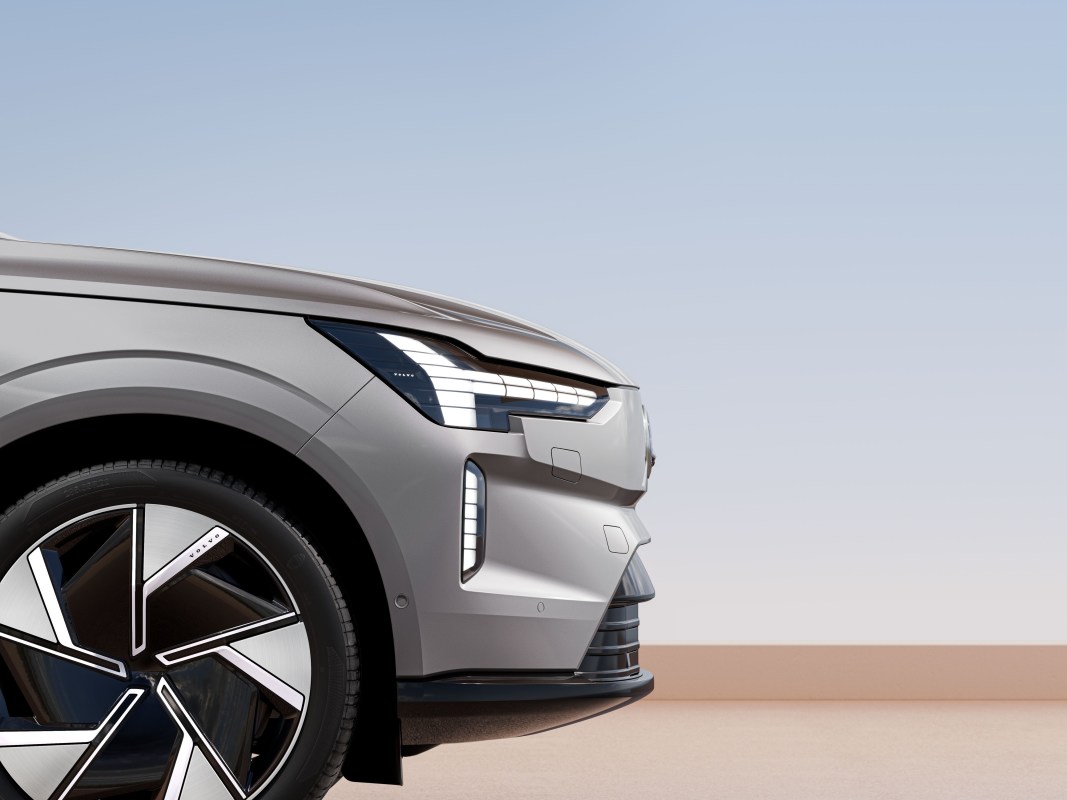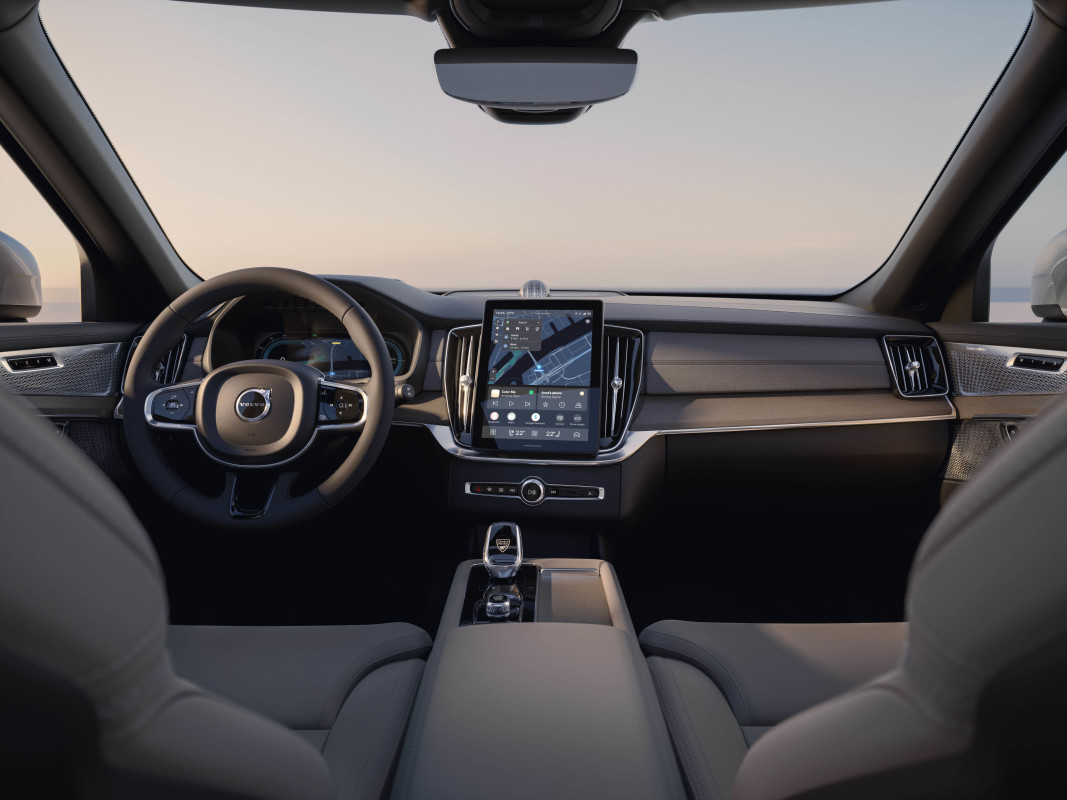With Volvo’s EX90 all-electric SUV electrifying the popular gas-powered XC90, it might seem counterintuitive to consider the plug-in hybrid version. However, with an update inside and out, the freshly revealed Volvo XC90 plug-in hybrid is more enticing than ever. Now known as the T8 version, it offers 33 miles of pure electric range. Despite delays and price increases, the EX90 is finally on its way, and the revamped XC90 PHEV is expected to follow closely behind in the new year. This is a tale of two flagship SUVs with key differences.
The EX90 is not just an electrified XC90
While both SUVs can seat up to seven (with a six-seat configuration option), the EX90 is technically longer at 198.3 inches compared to the XC90’s 195 inches. Although it has a similar shape and size to the original XC90, the EX90 has a distinct “electric look” that matches Volvo’s other EVs like the EX30. Inside, you’ll find similar legroom, headroom, and cargo space, but with a more updated tech display up front on the all-new EX90.
2025 Volvo EX90.
Platform differences between EX90 and XC90 PHEV
The EX90 is built on the SPA2 platform, which is an evolution of the SPA (Scalable Product Architecture) platform found in the XC90 plug-in and other versions of the XC90. The EX90 was designed as a dedicated electric vehicle with a low-lying base that accommodates the battery and motors.
Powertrain differences go beyond battery size
XC90 PHEV:
The T8 PHEV is a plug-in hybrid, meaning it has an inline four-cylinder gas engine paired with a single electric motor. Its lithium-ion battery has a capacity of 18.8 kWh, providing up to 33 miles of pure electric range. It offers all-wheel drive with 310 horsepower and 295 pound-feet of torque. The zero-to-60 mph time is 5.1 seconds, and its fuel economy stands at 58 MPGe combined.
EX90:
The EX90, on the other hand, is all about the battery. It offers a 310-mile range (or 300 miles with larger wheels) from its 111-kWh battery. The EX90 is available in two configurations: Twin Motor or Performance. The base Twin Motor produces 402 horsepower and 361 pound-feet of torque, achieving a zero-to-60 mph time of 5.7 seconds (or 4.7 seconds for the Performance version). The fuel economy is rated at 84 MPGe. Both versions are all-wheel drive, as expected for an EV.
Charging experiences differ significantly
While both can be plugged in, the smaller XC90 battery with its 6.4 kW onboard charger takes 3 hours to charge from empty to 100%. Using a home 120-volt outlet, this charging time increases to 7 hours.
As battery power is the only option for the EX90, charging differs significantly. At home, it takes 10 hours to reach a full charge for the 111 kWh battery. However, on the road at public charging stations, it only takes 30 minutes to go from 10% to 80% using a 250 kW DC fast-charging plug.

Volvo

Similar tech experience with Google built-in
With updates to the XC90 PHEV, the center screen now mirrors the EX90’s setup, featuring a free-standing 11.2-inch touchscreen. The EX90, however, has a larger 14.5-inch center display and a 9-inch digital driver screen, with a noticeably different layout than what’s found behind the XC90’s steering wheel.
Both SUVs use the Google-integrated infotainment system, known as Google built-in, which seamlessly incorporates Google Maps and other Android-based apps. Apple CarPlay is still available with a wired connection to an iPhone. With the XC90’s 2025 debut, a new user experience with a more intuitive layout will be introduced on the touchscreen. New EX90 and EX30 models will also feature this new screen. All Volvos from 2020 and newer will eventually receive the over-the-air update.
2025 Volvo XC90 PHEV. Volvo
What’s new for the XC90 PHEV?
The XC90 has been around since 2002, with the plug-in version arriving as the T8 Recharge in 2016. For 2025, the plug-in is simply known as the XC90 T8. Its most obvious change is a new front-end design.
The hood and bumper have been redesigned with a noticeably different grille and lighting setup. The classic Thor’s Hammer headlights are now slimmer. Volvo states these subtle design changes aim to connect the plug-in to its all-electric siblings, with a look that aligns with the growing battery-based lineup.
Related: 2025 Volvo XC90 gets new look, better tech, improved ride in heavy refresh
Pricing differences between XC90 PHEV and EX90
The XC90 is slightly more affordable, even in its top-of-the-line T8 plug-in configuration. While official pricing hasn’t been announced for the refreshed model, it’s expected to start around $74,000. The trims will continue as Core, Plus, and Ultra, as they have been previously. The base XC90 (non-plug-in) will start at $58,450, plus a $1,295 destination fee.
The EX90 starts at $79,995, excluding the $1,295 destination fee. The seven-seater comes standard in the Plus trim, with the Plus six-seater configuration priced at $81,790 and Ultra seven- and six-seater versions priced at $85,640 and $86,140, respectively. The same trims are available for the Performance version for an additional $5,000.
Availability of the 2025 XC90 PHEV and EX90
The EX90 started deliveries this month, while the new XC90 PHEV won’t be available until 2025. The EX90 was initially expected to arrive mid-year but faced delays that pushed its launch back several months.
The EX90 is being produced at Volvo’s South Carolina plant, while the XC90 will begin production by the end of the year in Sweden, where Volvo is headquartered.
Final thoughts
Choosing between the EX90 and XC90 PHEV feels like navigating Volvo’s own transition as it redefines its future. The EX90 represents the 100% battery-powered future that Volvo is striving for, while the XC90 plug-in hybrid is a more pragmatic choice. With 33 miles of pure electric range, it allows drivers to experience an electric lifestyle without entirely giving up traditional driving expectations. With similar tech and design, the decision ultimately comes down to whether you’re ready to commit to an all-electric lifestyle or prefer the flexibility of a plug-in hybrid.
Related: 2025 Volvo EX90 First Drive: Electric? Three rows? Luxury? Here’s your choice

